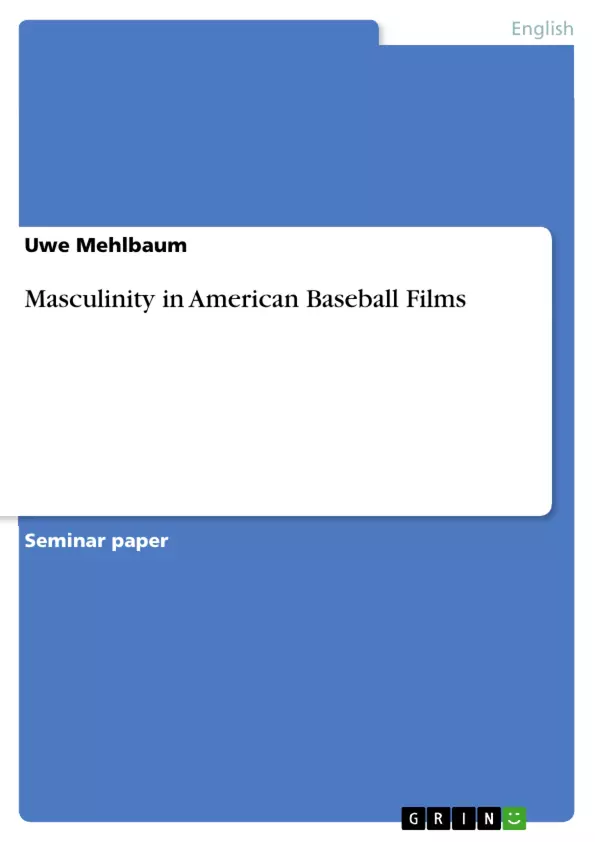In the United States of the mid-19th century, the game of Baseball became popular to such an extent that it was from then on closely associated with American national culture as such. The “National Pastime”, the “American Game” or even the “National Religion” as the sport also soon was called, represented not only American values like teamwork and meritocracy, but also to a certain degree symbolized the expansion, industrialization and the economic boom in the United States of the 19th century. Baseball has therefore been an important topic in many works of American literature and films ever since. Hence, among many other points of view, American baseball fiction has also shaped the perception of American masculinity. The concept of masculinity is important in the academic field of gender studies which came up only as recent as the 1970s. In its first part, this paper is going to explain the concepts of gender and masculinity and the complexity which surrounds them in some detail. Secondly, this paper is going to approach some works of baseball fiction from the 1980s and early 1990s from the gender studies-perspective, namely the films Bull Durham (1988), The Natural (1984), Mr. Baseball (1992) and A League of Their Own (1992). It will try to answer the question what conclusions can be drawn concerning the representation of masculinity in American baseball films of the 1980s and early 1990s.
Inhaltsverzeichnis (Table of Contents)
- I. Introduction
- II. The topic of masculinity
- IIa. The difference between "sex" and "gender"
- IIb. Modernisation and patriarchy
- IIc. Gender fluidity and alternative masculinities.
- IId. Masculinity in all-male-groups: Aggression, struggles for power and homosocial bonding.
- III. Masculinity in American baseball films
- IIIa. Bull Durham (1988)
- IIIa1. Crash as an embodiment of ideal masculinity
- IIIa2. Female masculinity and modern femininity: the character of Annie.
- IIIb. The Natural (1984)
- IIIc. Mr. Baseball (1992)
- IIId. A League of Their Own (1992)
- IV. Summary
- V. Works cited
Zielsetzung und Themenschwerpunkte (Objectives and Key Themes)
This paper explores the representation of masculinity in American baseball films of the 1980s and early 1990s. It investigates the complexities of masculinity as a concept, drawing on gender studies and examining the portrayal of male characters in popular cinema.
- The evolving concept of masculinity in modern society
- The relationship between gender and cultural context
- The portrayal of traditional and alternative masculinities in American baseball films
- The impact of social changes on masculinity and gender roles
- The influence of popular culture on perceptions of masculinity
Zusammenfassung der Kapitel (Chapter Summaries)
The first chapter introduces the concept of masculinity, its significance in the context of American baseball films, and the evolution of the term in relation to gender studies. It delves into the distinction between sex and gender, highlighting the complexities of masculinity in a changing world.
Chapter II explores the historical and societal factors that have shaped the concept of masculinity, such as the decline of traditional patriarchal structures and the rise of feminist movements. It examines the evolving role of men in society and the challenges they face in adapting to new social norms.
Chapter III examines how masculinity is portrayed in four American baseball films: Bull Durham, The Natural, Mr. Baseball, and A League of Their Own. It explores how each film presents different facets of masculinity, ranging from traditional masculine ideals to more fluid and alternative representations.
Schlüsselwörter (Keywords)
This paper focuses on the key concepts of masculinity, gender, and gender studies as they relate to the representation of male characters in American baseball films. It explores themes such as traditional masculinity, modern masculinity, gender roles, social change, and the influence of popular culture on perceptions of masculinity.
- Quote paper
- Uwe Mehlbaum (Author), 2010, Masculinity in American Baseball Films, Munich, GRIN Verlag, https://www.grin.com/document/163938



